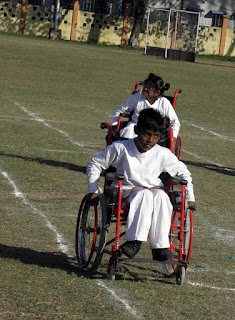INTELLECTUAL DISABILITY
The
term intellectual disability includes impairments of general mental abilities
that impact adaptive functioning. Symptoms of intellectual disability first
appear during the developmental period and diagnosis requires a comprehensive assessment
of intelligence across conceptual, social, and practical domains (American
Psychiatric Association, 2013). Adaptive skill areas include:
· Conceptual
· Language
· Reading
· Writing
· Math
· Reasoning
· Knowledge
· Memory
· Social
· Empathy
· Social
judgment
· Interpersonal
communication skills
· Ability
to make and retain friendships
· Practical/self-management
· Personal
care
· Job
responsibilities
· Money
management
· Recreation
· Organizing
school and work tasks
Almost
10% of children with hearing loss also have intellectual disabilities. Those with
an intellectual disability are at an increased risk for visual or hearing
impairment or both. Detection and treatment of hearing loss in adults and
children with intellectual disabilities is of utmost importance because hearing
loss can exaggerate intellectual deficits by impeding the learning process. Down
syndrome, also referred to as trisomy 21, is the leading cause of hearing loss
and intellectual disabilities and occurs in approximately 1 in 700 births in
the United States. Audiologists are very
likely to see a large number of children and adults with Down syndrome, a
genetic disorder always associated with some degree of cognitive impairment. As
individuals with Down syndrome age, there is a decline in intellectual ability.
In fact, almost 100% of individuals with Down syndrome over 40 years of age
demonstrate degenerative neuropathologic changes consistent with Alzheimer-type
dementia.
Furthermore,
some have speculated that the precocious aging of individuals with Down
syndrome results in early presbycusis in this population. Hearing loss
progresses more rapidly in adults with Down syndrome than those with other
forms of intellectual disability or adults in the general population. Down
syndrome is also frequently associated with conductive hearing loss and, less often,
sensory/neural hearing loss. Although the majority of the conductive hearing
losses in those with Down syndrome are secondary to middle ear effusion, some
are the result of middle ear anomalies, such as ossicular malformations and
damage to middle ear structures as a result of chronic infection. In contrast
to the typically developing population, the prevalence of middle ear effusion
tends to remain high in individuals with Down syndrome regardless of age. Found
that adolescents with Down syndrome have poorer hearing and greater incidence of
conductive hearing loss than their peers with intellectual disability, but without
Down syndrome. For a comprehensive review of hearing loss associated with Down
syndrome.
Special
Testing Considerations
Little has been published on hearing
assessment of adults with intellectual disability. However, it is well
documented that audiologists must use test techniques that will bridge the difference
between the chronologic and developmental age of individuals with cognitive
disabilities to obtain valid test results. The patient’s mental or
developmental age, not their chronologic age, should be considered when
selecting appropriate test procedures and materials. Several investigators have
evaluated the effectiveness of VRA with children having intellectual
disabilities, including those with Down syndrome. With typically developing children
and those with intellectual disabilities, VRA is effective with infants as
young as 6 months cognitive developmental age. However, children with Down
syndrome require a cognitive developmental age of 10 to 12 months to successfully
participate in a VRA procedure. Furthermore, behavioral thresholds of infants
with Down syndrome have been found to be 10 to 25 dB poorer than those of
typically developing infants when all had normal hearing verified via ABR. This
elevation of behavioural thresholds is presumed to be the result of more
inattentive behavior on the part of the children with Down syndrome relative to
their typically developing peers. Moreover, this inattentive behavior provides
additional reason to utilize a test battery that includes physiological
measures when testing children with Down syndrome. Although it is recommended
that audiologists attempt to elicit a spontaneous head-turn response during the
VRA conditioning process, some children with intellectual disability may not
have developed auditory localization ability. Recall that auditory localization
is a higher order skill than detection, the required skill for VRA. In such
cases, several administrations of paired conditioning trials may be required.
If the patient does not respond to the auditory stimuli, the audiologist may be
left with the question, “Does the patient not hear the stimuli, or can she or
he not perform
the task?” One method that can answer this question is for the audiologist to
place the bone vibrator either in the patient’s hand or on the head and, using
a low-frequency stimulus at approximately 50 to 60 dB hearing level (HL),
determine if the patient can perform the task using this vibrotactile cue. In
this way, the patient is able to feel the stimulus and, thus, is not required
to hear to participate. If the patient is able to cooperate for the task under
these vibrotactile conditions, then the audiologist should return to the
auditory stimuli and continue testing with the knowledge that the patient
understands the task. If using a play audiometric technique, it is often
appropriate for the audiologist to demonstrate the play task to the patient
with intellectual disability rather than attempting to
explain the instructions verbally. Because learning the desired response
behaviors may take longer for children and adults with intellectual disability,
it may be useful to have them practice the listening task at home before coming
to the clinic.

No comments:
Post a Comment